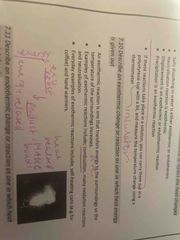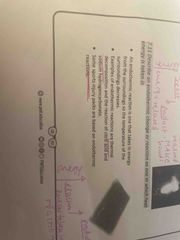![]()
![]()
![]()
Use LEFT and RIGHT arrow keys to navigate between flashcards;
Use UP and DOWN arrow keys to flip the card;
H to show hint;
A reads text to speech;
20 Cards in this Set
- Front
- Back
- 3rd side (hint)
|
how do you salts, neutralisation, displacement and precipitation reaction, and an extra thermic reaction is |

Back (Definition) |
|
|

How does an exothermic change your reaction open and what properties does it have? |

Back (Definition) |
|
|
|
describe an endothermic, change your reaction as one in which heat energy is taken in |

Back (Definition) |
|
|
|
what happened to the of bonds? In Endo and exothermic reactions. |

Back (Definition) |
|
|
|
Calculate the energy change in a reaction, given the energies and bonds |
Back (Definition) |
|
|
|
What is the formula for energy change? |

Back (Definition) |
|
|
|
What does the term activation energy mean? |
Back (Definition) |
|
|
|
What does an exothermic reaction profile look like? |
Back (Definition) |
|
|
|
describe an exothermic reaction profile diagram |
Back (Definition) |
|
|
|
What does an endothermic reaction profile look like? |
Back (Definition) |
|
|
|
Describe an endothermic reaction profile |
7.16 Draw and label reaction profiles for endothermic and exothermic reactions, identifying activation energy • Reaction profiles can be used to show the relative energies of reactants and products, the activation energy and the overall energy change of a reaction.
• for the endothermic diagram, the reactants have less energy than the products, because the energy has been taken in from the surroundings |
|
|
|
explain the core practical investigating the effect of changing the conditions of a reaction on rate of chemical reactions by measuring the production of gas and change of colour |
Back (Definition) |
in these experiments, you are investigating the effect on rate of changing the size of the marble chips (smaller chips=larger surface area= faster rate) and also the effect of changing the concentration of hydrochloric acid (greater concentration= greater number of particles in a given volume= faster rate) - Freqvency. 2 Suggest practical methods for determining the rate of a given reaction cel |
|
|
Explain or suggest a practical method for determining the rate of a given reaction |
Rates of reactions can be measured using the amount of product used, or amount of product formed over time: Rate of reaction = amount of reactant used Time |
|
|
|
Part two |
Rate of reaction = amount of product formed Time o Quantity of reactant or product can be measured by the mass in grams or by a volume in cm? o Units of rate of reaction may be given as g/s or cm≥/ to measure reactant used: if the product is a gas, which will be given off, you can carry out the reaction on a set of weighing scales and measure how much mass is lost o to measure product formed: if the product is a gas, you can measure the volume of gas produced in a gas syringe |
|
|
|
explain her reaction is occurring particles, collide and the rate of reaction increase in frequency and energy of collisions increased |
Back (Definition) |
|
|
|
It’s mainly affects on rates of reaction of changes in temperature concentrations of area to volume ratio |
Back (Definition) |
|
|
|
The product of the reaction, how do you expect the mass volume and concentration to look for me? how do you expect the reactant to be as well |
Back (Definition) |
|
|
|
What is a catalyst? |
Back (Definition) |
|
|
|
Explain how the addition of a catalyst increases the rate of reaction in terms of activation energy |
Back (Definition) |
|
|
|
What is a biological catalyst? and an example of one and what it is useful for |
Enzymes act as catalysts in biological systems Yeast is the enzyme used in the production of ethanol as it is fermented from sugars, ethanol is in alcoholic drinks |
|

